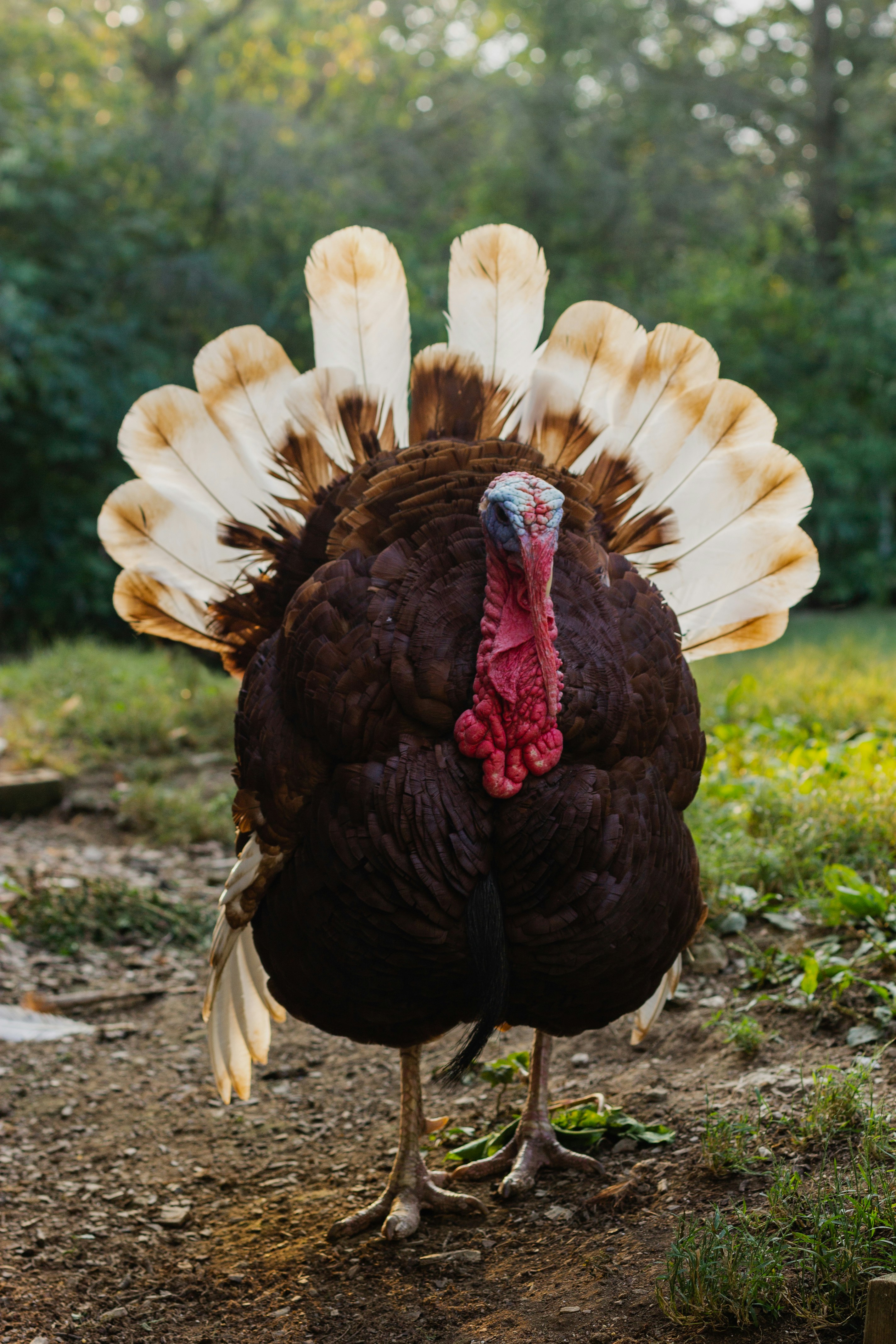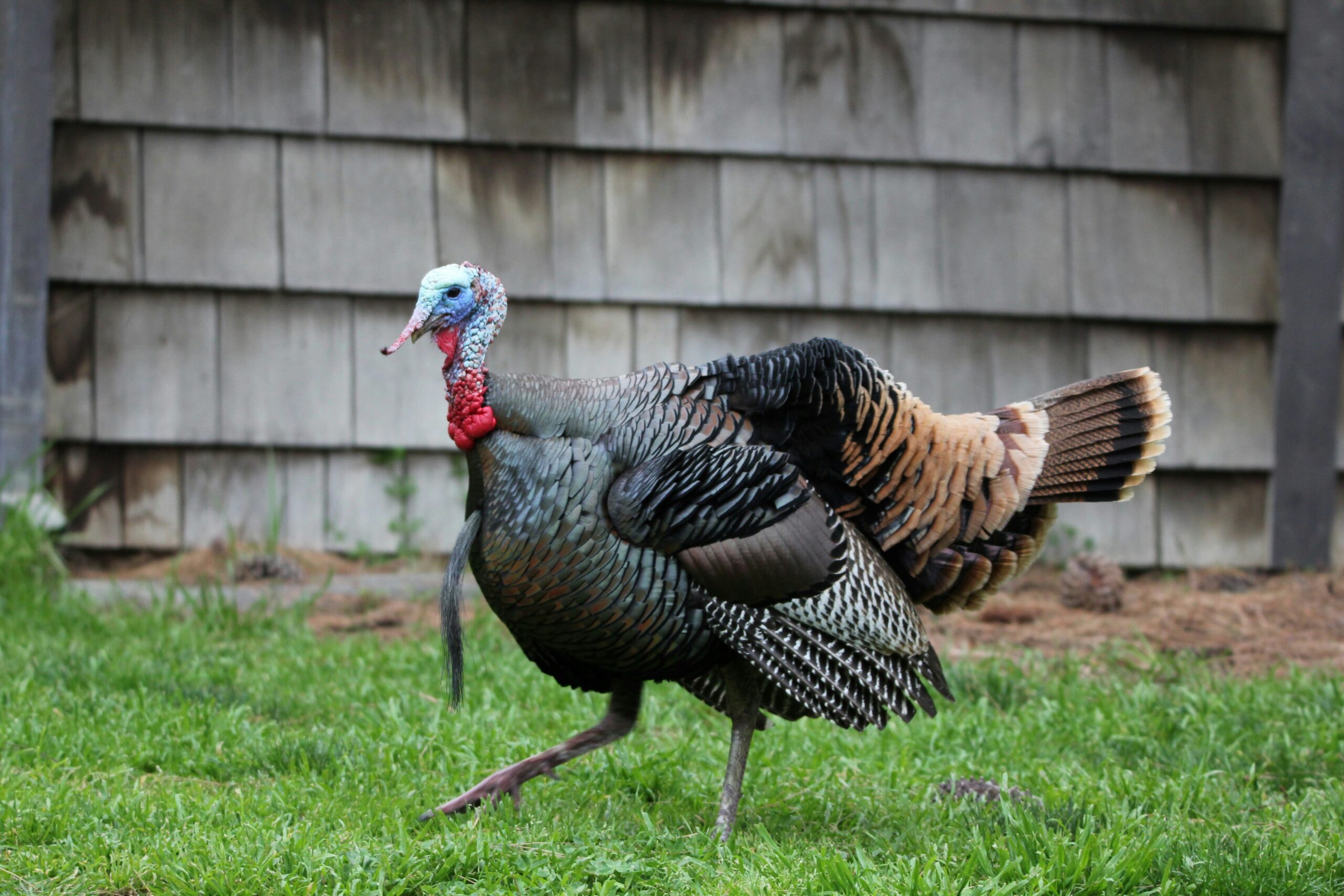From color-changing wattles and courtship struts to near-extinction comebacks and spiral poo, there’s much to appreciate about the magnificent Wild Turkey.
Here are a few of our favorite turkey fun facts to gobble up this Thanksgiving.
1. Turkeys Don’t Just Gobble. They Cluck, Purr, Cackle & Yelp.
Only male Wild Turkeys, or toms, gobble. Also appropriately known as gobblers, they do so toward females, or hens, during mating season—showing off their colorful plumage, tail fans, and strutting to impress them. Females, by contrast, tend to make more subdued sounds, such as purrs, clucks, and yelps.
But these calls aren’t just for attracting mates; turkey calls also serve several other purposes, including:
- Clucking: gets the attention of another turkey
- Assembly Calls: used by hens to gather a scattered flock back together
- Cluck & Purr: expresses contentment
- Putt: expresses alarm and signifies danger

2. Turkeys Can Fly.
Despite their large stature (males weighing anywhere between 11 and 24 pounds and females at around half that size), turkeys can fly about 55 miles per hour for a short distance.
Sure, it might seem like small potatoes compared to, say, the Peregrine Falcon, which can fly upwards of 200 miles per hour, but these short bursts enable turkeys to flee up into trees where they roost for the night to successfully evade predators.
3. They Have Color-Changing Wattles & Snoods.
Did you know that certain parts of a turkey can change color based on its mood?
Perhaps one of the most recognizable aspects of these birds, wattles are the often red, bumpy flesh hanging from a turkey’s head. During mating season, extra blood rushes to the wattle—making it appear especially red to attract the hen—but when it’s colder out, the blood can retract and the wattle turns blue.
Another notable part of the turkey’s face, the snood—or, the ribbon-like growth on the tom’s forehead—can fluctuate between red, pink, blue, or white during mating displays, reads an article from Audubon Magazine. Talk about nature’s mood ring!
4. They Grow Beards.

Picture the consistency of a small horsetail and that’s the feel of a turkey’s beard, explains retired gamebird biologist Gary Norman, from the Virginia Department of Game and Inland Fisheries, in the aforementioned Audubon Magazine article.
And it’s not just males—hens can rock the beard, too.
However, the 10% of females who do have these beards typically grow thinner, wispier hairs than their male counterparts, whose chests spout the brown and black hair-like feathers from the time they are just five months old, the article continues.
5. Turkeys Strut.
Forget fashion shows. Turkeys really know how to strut their stuff during mating season.
Toms’ courtship displays—which involve fanning their tails, puffing out their feathers (some of which they drag along the ground), and making spitting and drumming sounds—are aimed at attracting hens. Females typically choose a mate based on these attributes, along with other physical characteristics such as the snood—which is longer in older toms, indicating good genetics.

6. They Have Between 5,000 & 6,000 Feathers.
Wild Turkeys have various types of feathers, each of which serves a distinct purpose for everything from flying and insulation to camouflage and ornamentation.
By design, these feathers grow in tracks, or pterylae, to ensure the entirety of the bird is covered—especially when molting, during which turkeys will not lose feathers in the adjacent track for this reason.
7. They Have Amazing Vision.
Wild Turkeys—and all birds, for that matter—can perceive color better than humans, thanks to their extremely complex retinas. While the human eye has four types of photoreceptors (one rod and three single cones), turkey retinas boast seven (one rod, four single cones, and two double cones)—enabling them to perceive a much wider spectrum of colors than humans.
To boot, they have impressive monocular periscopic vision, with eyes on either side of their heads that can move independently of each other—affording them a 270-degree field of view at all times without even moving their heads.
8. Ben Franklin Was a Fan.
The myth that Franklin had advocated for the national bird to be changed from a Bald Eagle to a turkey was just that: a myth.
The idea stems from a letter he wrote to his daughter, in which he joked that the turkey was a “much more respectable bird” than the Eagle—not to mention, a “true original native of America.” In the letter, he also wrote that the Eagle was a “rank coward” and could be driven “out of the district” by a “little king bird,” which he said did not embody the “brave and honest Cincinnati of America, who have driven all the king birds from our country.”
Yet although Franklin favored the Wild Turkey, he did not officially advocate for the national bird to be replaced.
9. Baby Turkeys Are Called Poults.
Get it? Poult, poultry?
From the time a baby turkey hatches until they begin growing feathers and flying, they are referred to as a poult. This phase usually spans until about 4 or 5 weeks of age, after which the bird becomes a juvenile.
10. Droppings Can Tell About its Sex & Age.
You read that right. Toms tend to leave elongated, J-shaped droppings, while hens’ are typically spiral and rounded. Plus, larger scat means it’s an older bird.
The more you know.
11. They Nearly Went Extinct.
Due to overhunting and habitat loss, the Wild Turkey population plummeted to just 30,000 in the United States during the early 1900s. Thankfully, due to conscientious habitat restoration efforts, reintroduction programs, and legislation—such as the Federal Aid in Wildlife Restoration Act of 1937, which taxed guns and ammunition—populations have since increased.
The number currently rests around 6.9 million in the United States, and includes one of the bird’s two species (the Meleagris gallopavo) and within it, five subspecies (Eastern, Osceola, Merriam’s, Gould’s, and Rio Grande).
12. They’re One of Two Domesticated Native Birds.
Alongside the Muscovy Duck, the Wild Turkey is one of only two domesticated birds native to America, believed to be raised by Native Americans in Mexico and Central America as early as 25 A.D.
In the early 1500s, Spanish explorers took turkeys from America back home with them, only to bring them back to the New World during their colonization a few centuries later.
Buffalo Audubon leads and inspires Western New Yorkers to connect with and protect the natural world through bird-focused activities, advocacy, and habitat restoration. Visit our website to learn more about upcoming birding programs and events, becoming a member, planning your next visit, or ongoing advocacy efforts such as Bird-Friendly Buffalo.


Leave a Reply